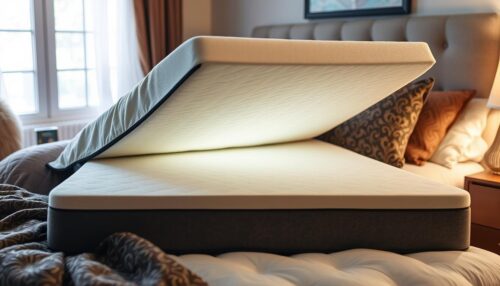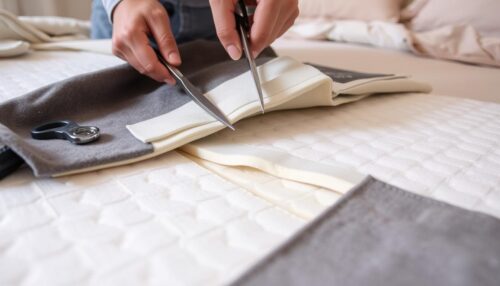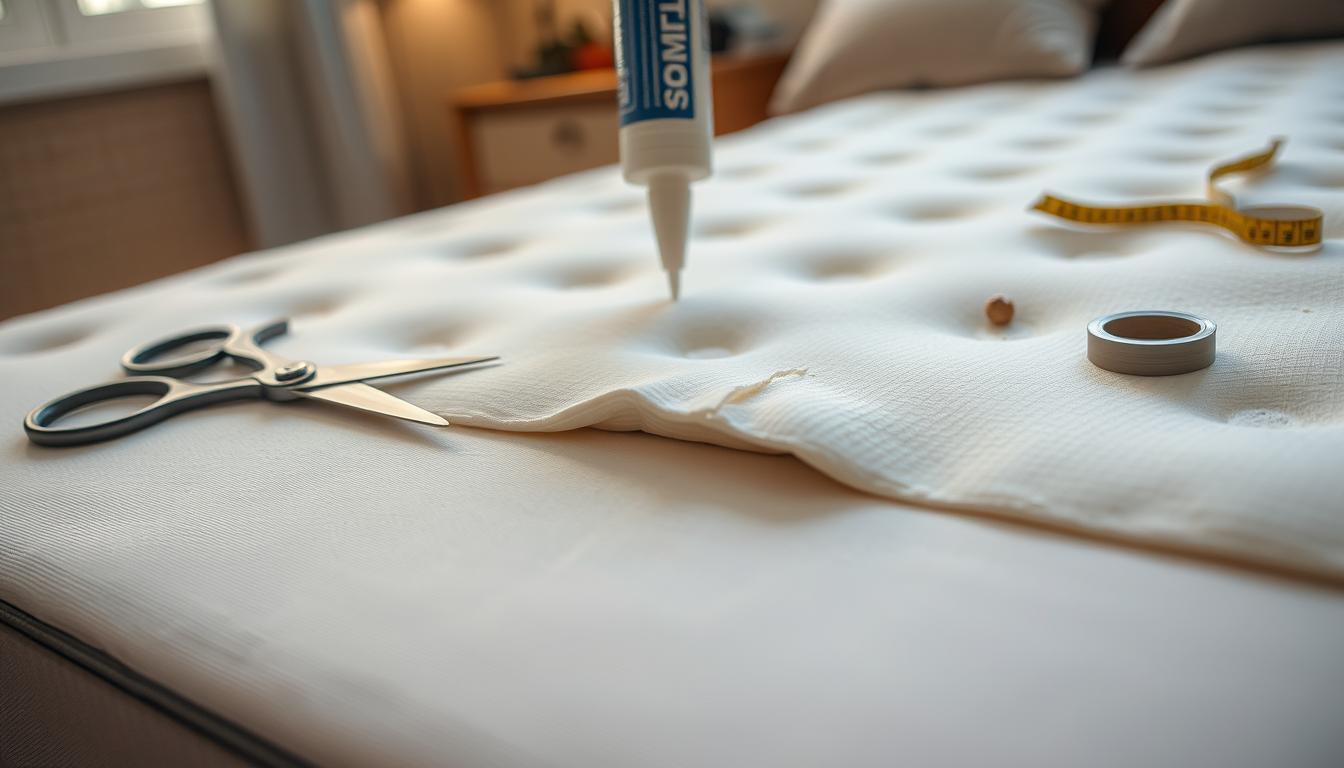Disclosure
This website is a participant in the Amazon Services LLC Associates Program, an affiliate advertising program designed to provide a means for us to earn fees by linking to Amazon.com and affiliated sites.
Are you upset about your memory foam mattress topper getting worse? It might have holes, tears, or sagging. This can mess up your sleep and comfort. But don’t worry, we’ve got a detailed guide to help you fix and keep your topper in great shape.
Key Takeaways:
- Understand the common problems that can affect memory foam mattress toppers
- Learn how to identify signs of wear and tear to determine when repair or replacement is necessary
- Discover effective cleaning and deodorizing methods to keep your topper fresh and hygienic
- Master step-by-step repair techniques for small cuts, tears, and indentations
- Explore ways to provide additional support and extend the lifespan of your memory foam topper
Understanding Your Memory Foam Mattress Topper
A memory foam mattress topper can really change your sleep game. But to get the best out of it, knowing how memory foam works is key. It’s all about how it can make your sleep better.
What is Memory Foam?
Memory foam is made from polyurethane, a material NASA created for seats in planes. It’s special because it shapes to your body. This means it gives you the right amount of support and pressure relief.
Its viscoelastic nature lets it adjust to your body’s shape. This even distribution of weight helps reduce pressure points.
Benefits of a Mattress Topper
Using a memory foam mattress topper can bring many benefits. It can make your old mattress feel new again by adding comfort and support. It’s also great for back pain, aligning your spine, and stopping motion from disturbing your sleep.
Common Issues with Mattress Toppers
- Tears and rips in the foam over time
- Sagging and indentations from regular use
- Unpleasant odors from trapped moisture or bacteria
Knowing about these problems helps you take care of your topper. This way, it keeps giving you comfort and support for a long time.
Identifying Damage on Your Mattress Topper
Keeping your memory foam mattress topper in good shape is key. It helps it stay comfy and supportive for longer. Regular checks can spot problems early, so you can fix them before they get worse. Knowing common issues helps you keep your topper in great shape.
Signs of Wear and Tear
Look for tears, cracks, or dents in the foam. These can happen as it gets used and pressed. If the foam feels harder or uneven, it’s a sign it needs attention.
How to Check for Vulnerabilities
Check the edges and corners of the topper first. These areas get damaged more easily. Press and move the foam gently to find soft spots or where it’s losing support.
When to Consider Replacement
If you’re fixing your topper a lot, or it’s not as comfy as before, it’s time for a new one. Watching your topper’s condition helps you know when to get a new one.
Regularly checking your memory foam mattress topper helps find problems early. This way, you can keep it in good shape for years. With the right memory foam topper maintenance, it will stay comfy and supportive for a long time.
Cleaning Your Memory Foam Mattress Topper
Keeping your memory foam mattress topper clean is key to its longevity and comfort. Regular cleaning keeps it fresh and prevents odors, dust, and allergens. Here are the best ways to clean your memory foam topper.
Basic Cleaning Techniques
Begin by vacuuming the topper gently to remove dust and hair. Use the upholstery attachment for the best results. Then, clean any stains with a mild detergent and warm water, but avoid soaking the foam.
Deep Cleaning Methods
For a deeper clean, try a steam cleaner. Steam can sanitize and refresh the foam. Make sure it dries completely before putting it back on your mattress.
Tips for Stubborn Stains
Stubborn stains can be tough, but baking soda can help. Mix baking soda with water to make a paste. Gently scrub the stain, then blot it with a damp cloth. This method can remove tough stains without harming the foam.
Remember, memory foam topper maintenance is vital for its comfort and life. By following these cleaning tips, your topper will stay in great shape for many years.
Repairing Small Cuts and Tears
Fixing small cuts and tears in your memory foam mattress topper is easy. You just need the right stuff and a little care. Follow these steps to make your topper look new again.
Materials You’ll Need
- Specialized polyurethane foam glue
- Scissors or sharp knife
- Clean cloth or paper towels
- Weights or heavy objects (optional)
Step-by-Step Repair Process
- Clean the area around the cut or tear with a cloth or paper towels. This helps the glue stick better.
- Put a small amount of foam glue on the tear. Make sure to cover the whole tear.
- Press the edges of the tear together carefully. Try to line them up right.
- If needed, use weights to hold the tear in place while the glue dries. It takes about 8 hours.
- After the glue dries, your topper should be fixed!
Alternative Repair Solutions
For big tears or serious damage, you might need a different fix. Use a foam and upholstery fabric patch. Clean the area, apply glue, and press the patch on firmly. This makes a strong and lasting repair for big damage.
By following these steps, you can fix your DIY memory foam topper repair easily. Remember, stopping problems early is best. Check your topper often and fix small issues quickly. With a bit of care, your fixing damaged memory foam topper will last a long time.
Addressing Indentations and Sagging
Memory foam mattress toppers can really improve your sleep. But, they can get indented and sag over time. This can make them less comfortable and supportive. Luckily, there are ways to fix these problems and make your topper feel new again.
Understanding Indentation Causes
Indentations happen for a few reasons. Too much pressure or heat can break down the foam. Also, if your mattress isn’t supportive or is uneven, it can cause dips.
Quick Fixes for Sagging Foam
- Flip and rotate your memory foam topper regularly to distribute wear and tear evenly.
- Expose the topper to sunlight, which can help rejuvenate the foam and minimize sagging.
- Use a mattress pad or protector to create a barrier between your body and the topper, helping to maintain its shape.
Long-term Solutions for Better Support
For deep indentations or sagging, you might need a bigger fix. Adding support under your topper can really help. You could use a mattress foundation, box spring, or even flat pillows or plywood.
Getting a top-quality memory foam topper refurbishing or restoring memory foam mattress pad is also a good idea. Look for ones with durable, high-density foams that last longer.
Fixing indentations and sagging can make your topper last longer. It will keep giving you the comfort and support you need for a great sleep.
Dealing with Odors
Keeping your memory foam mattress topper fresh is key for a good night’s sleep. Sometimes, memory foam can smell bad. This might be because of moisture, sweat, or chemicals from the foam. But, there are ways to make your topper smell nice and fresh again.
Common Causes of Odors
Memory foam can smell when it’s new because of gases trapped inside. These smells usually go away in a few days. But, if your mattress was wrapped in plastic, it might still smell. Over time, the foam can break down and smell bad too.
Effective Deodorizing Techniques
One good way to get rid of bad smells is to sprinkle baking soda on the topper. Let it sit for a few hours, then vacuum it up. Baking soda pulls out and gets rid of bad smells. You can also use a mix of white vinegar and water to fight off bad smells.
Natural Deodorizer Options
- Essential oils: Mix a few drops of your favorite essential oil, like lavender or lemon, with water in a spray bottle. Spray the topper to make it smell nice.
- Activated charcoal: Put small bags of activated charcoal near your topper. They soak up bad smells and moisture, keeping your topper fresh.
It’s also important to let your topper breathe. Open windows and let sunlight in. This helps get rid of bad smells faster and keeps your bed smelling fresh.
Plant-based memory foam mattress topper is a good choice for those who want to avoid bad smells and off-gassing.
Adding Support Underneath Your Mattress Topper
Keeping your memory foam mattress topper in good shape needs a strong base. A solid base stops sagging. This keeps your topper comfy for many years.
Importance of a Solid Foundation
A weak base can make your topper sag early. This makes sleeping uncomfortable and shortens your topper’s life. It’s key to keep your topper supported well for memory foam topper maintenance and prolonging memory foam topper lifespan.
Choosing the Right Mattress Base
Look for a base like a platform bed or box spring. They give a stable, even surface. This stops your topper from sagging. Don’t use old, worn-out bases as they lack support.
DIY Support Options
- Add a plywood board: Place a sturdy plywood board between your mattress and box spring or foundation to create a solid, even surface.
- Use bed risers: Elevate your mattress and topper with bed risers, ensuring a level sleeping platform.
- Reinforce slats: If using a slatted bed frame, make sure the slats are no more than 2.75 inches apart to maintain proper support.
Choose any method to get a stable, level base. This will prolong the lifespan of your memory foam mattress topper. It keeps it comfy and supportive for a long time.

Rejuvenating Old Memory Foam
If your old memory foam mattress topper feels hard, don’t worry. You can make it soft again with a few easy steps. Memory foam can get stiff over time, but you can make it feel new again.
Methods to Restore Softness
Start by gently kneading the foam with your hands. This helps spread out the material and makes it soft again. You can also use a foam roller to massage it in small circles. This gentle action can make the foam feel better against your body.
Using Essential Oils for Freshness
To make your topper smell nice, add a few drops of essential oils. Lavender, eucalyptus, or peppermint oils are great choices. Rub the oils gently into the topper, but don’t soak it too much.
Storage Tips for Longevity
Storing your topper right is important to keep it lasting longer. Clean it well before storing, then roll it loosely. Store it in a breathable bag or container in a cool, dry place. This helps keep mold away and keeps the foam in shape.
By following these steps, you can revive your old memory foam mattress topper. It will feel comfortable and supportive again. With a little care, you can refurbish your memory foam topper and save money on a new one.
Covering Your Mattress Topper
Getting a good mattress topper can really improve your sleep. But, you need to cover and take care of it right. A cover keeps your topper safe from spills, stains, and daily wear. It also makes your topper last longer, saving you money.
Benefits of a Mattress Topper Cover
A good mattress topper cover has many benefits:
- It keeps your topper clean and fresh by protecting it from spills and stains
- It blocks dust, pet dander, and allergens from getting on the topper
- It helps keep the topper cool and dry, so it stays comfy and supportive
- It makes your topper last longer, so you get more value for your money
Choosing the Right Material
When picking a cover, look for materials that breathe well, last long, and are easy to clean. Here are some good choices:
- Cotton: It’s natural, soft, breathable, and you can wash it in a machine
- Bamboo: It’s eco-friendly, fights off germs, wicks away moisture, and keeps you cool
- Polyester: It’s affordable, resists stains, and is simple to take care of
How to Properly Secure the Cover
To keep your cover in place, follow these steps:
- Measure your mattress and topper to find a cover that fits well
- Choose covers with elastic corners or straps for a secure fit
- Make sure the cover’s edges are tucked under the mattress to avoid bunching
- Check the cover’s fit often and adjust it to keep it tight and smooth
By covering and caring for your memory foam topper right, you can enjoy a comfy sleep for many years. This way, you get the most out of memory foam topper maintenance and prolonging memory foam topper lifespan.
Seasonal Maintenance Tips
To keep your memory foam mattress topper in top shape, follow some seasonal care tips. These simple steps will help your topper last longer and keep your sleep comfy all year.
Best Practices for Maintenance
Deep clean your memory foam topper twice a year. Use a mild detergent and warm water to clean it. Let it dry fully before putting it back on your mattress.
Rotating and Flipping Your Topper
Rotate your memory foam topper every few months. This stops it from getting worn out in one spot. If it has two sides, flip it too to use both sides evenly.
When to Store Away
Keep your memory foam topper in a cool, dry spot during humid or wet seasons. This stops mold and mildew from growing. Always dry it out completely before storing it for a long time.
| Maintenance Task | Frequency | Why It’s Important |
|---|---|---|
| Deep Cleaning | Twice a year | Removes built-up dirt, oils, and odors to maintain freshness |
| Rotating | Every 3-4 months | Promotes even wear and prevents indentations or sagging |
| Flipping (dual-sided) | Every 3-4 months | Ensures both surfaces are used evenly for longevity |
| Storing Away | During humid seasons | Protects against mold, mildew, and moisture damage |
By following these seasonal tips, you can make your memory foam topper lifespan longer. This keeps your memory foam topper maintenance up for many years.
Understanding Warranty and Return Policies
Knowing about the warranty and return policies for your memory foam mattress topper is key. This info helps protect your investment and ensures you get the best from your purchase. Let’s explore the details.
Checking Warranty Terms
Mattress warranties can last from 5 to 20 years or even the mattress’s whole life. They usually cover defects like broken coils or sagging. But, it’s vital to read the warranty terms well. Things like spills or not following the maker’s advice can cancel the warranty.
What Repairs Are Covered?
Most warranties cover fixing or replacing the topper for defects. This includes sagging or material problems. It’s crucial to document any issues and talk to the maker about what’s covered.
How to Make a Claim
To make a warranty claim, you’ll need to show proof of the problem. This might be photos or a detailed description. Start by contacting the store where you bought it. They’ll help you with the claim process. Keep your receipt and warranty info ready.
Understanding your memory foam mattress topper’s warranty and return policies is important. It helps you know how to handle any problems. This way, you can keep your topper in good shape and protect your investment.

Knowing When to Replace
A memory foam mattress topper can last for years. But, sometimes it’s time for a new one. Look for signs like sagging, bad smells, or less support. Decide if fixing it or getting a new one is cheaper.
Signs You Need a New Topper
Deep impressions over 1.5 inches mean it’s time for a new topper. Sagging can hurt your back and side. Also, if it smells bad and won’t clean up, it’s time for a new one.
Evaluating Cost vs. Repair
Think about fixing your topper versus buying a new one. Small problems might be fixed, but big ones might need a new topper. Talk to a sleep expert to figure out the best choice.
Selecting the Right Replacement Topper
When picking a new topper, look at its thickness, density, and material. Choose one that’s at least 1.5 to 2 inches thick. This ensures it will last long and be comfy. Also, pick high-density foam for the best durability.

